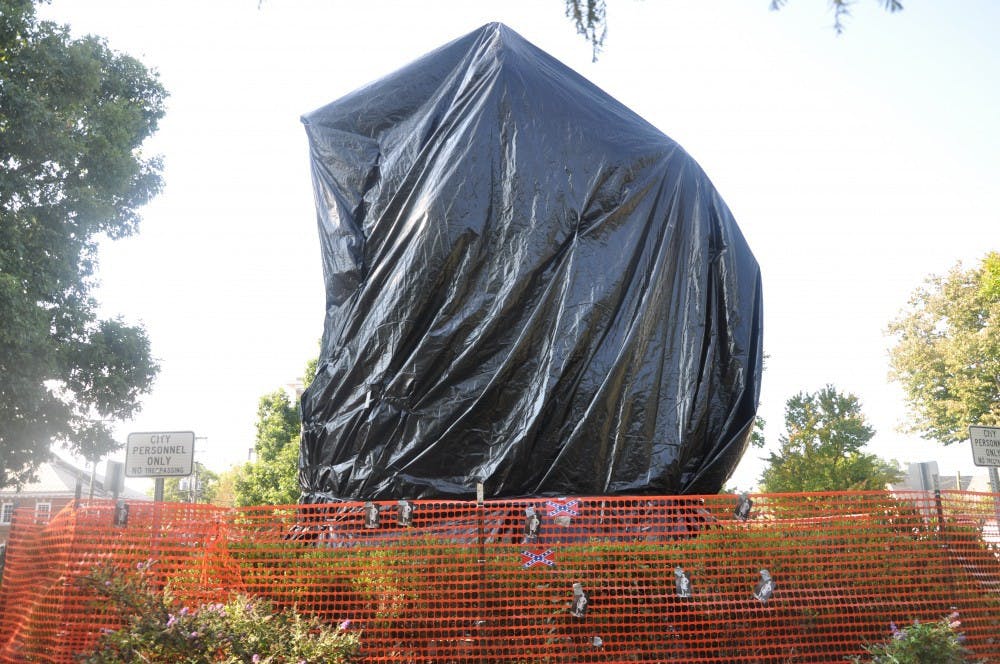In the aftermath of the events of Aug. 11 and 12, the issues of the the Robert E. Lee and Thomas “Stonewall” Jackson statues in Emancipation Park have only become more pressing for the City of Charlottesville. Not only did the statues previously represent nostalgia for the Confederacy’s era of white supremacy, but they also now symbolize violence of the Unite the Right rally and its victims, such as Heather Heyer. Aware of the statues’ polarizing presence in downtown Charlottesville, the City Council ordered that they be covered with tarps. This gesture was originally intended as a temporary sign of mourning and respect for the dead and those impacted by the violence. Unfortunately, the City’s choice to shroud the statue has only devolved into a legal battle and drain on taxpayer resources. As a city, we should encourage the City Council to stop indefinitely covering Lee and Jackson statues with a tarp in order to seek a more permanent form of their removal from the Charlottesville community.
Responses to the City Council’s choice to cover the statues with tarps have been contentious. The statue’s tarps have been taken down against the City’s wishes by unknown actors numerous times since August, with the most recent removals occuring as recently as Wednesday. In addition, legal action has been taken against the City of Charlottesville, with a collective of organizations and individuals filing suit against the City for its use of tarps. The group’s legal argument rests on their belief that the tarps “impede the public’s right to view the monuments,” copying the strategy of similar case involving Confederate statues that transpired in Birmingham, Ala. A judge heard oral arguments on the case Monday and is expected to make a decision on the issue later this month.
While the City remains in a legal battle in the courts over these statues and their removal, the question of tarps remains within the City’s realm of power. As of February, the tarps have been in use for over six months, extending well beyond their original purpose of mourning. Proponents of removing the statues have pointed out that periods of mourning rarely extend over half a year, bringing into question whether the City’s “temporary” policy on using tarps is truly temporary.
In addition, the policy of tarps has become a drain on Charlottesville taxpayers. The City has had to pay for multiple tarps, signage and additional labor to reinstall the tarps back into position. This also places Charlottesville law enforcement in a cat-and-mouse game of constantly attempting to secure the tarps, while tracking virtually untraceable agents who consistently remove them. In all, the statues have become a distraction for police, when other issues should be their focus, such as preparation for white nationalists’ possible return and citizens’ safety.
Instead of fighting an endless battle to keep tarps in place, the City should look to providing more permanent closure on the issue. The tarps themselves represent the City’s inability to make a lasting decision on the future of the Lee and Jackson statues as placeholders on the real issue of whether these statues should stand in the public forum. It’s clear that the statues of Robert E. Lee and Stonewall Jackson represent inaccurate, revisionist history that sought to intimidate minorities within the Charlottesville community. With the installation of the statues occuring in 1924 by Robert E. Lee’s granddaughter, these statues never were true historical relics of Confederacy, but rather a reaction by a public that sought to preserve what they called “the moral greatness of the Old South” — an ironic statement that underlines worst of white supremacists’ beliefs. In essence, there’s no destruction of history with the removal of these statues. These statues should be removed for their representation of false American values, which sought to uphold tenets of white supremacy. These white supremacist symbols don’t represent the ideals of Charlottesville, and the use of tarps only postpones real action to remove a blemish on Charlottesville’s landscape.
Use of the tarps does not provide closure — even temporarily — to the citizens of Charlottesville. Only the speedy removal of the statues will bring true justice to our community.







